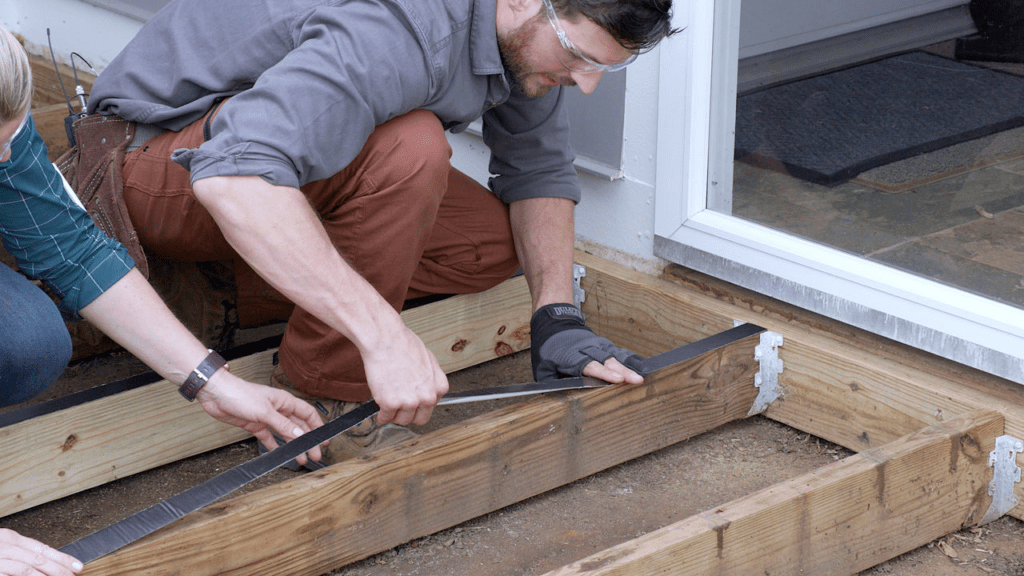Proper joist spacing is a foundational aspect of installing Trex decking. It ensures the longevity and stability of your deck while maximizing the performance of Trex composite materials. Whether you’re a DIYer or a professional contractor, understanding the recommended spacing and installation techniques will help you create a durable and beautiful deck that withstands the elements and heavy use.
Why Joist Spacing Matters
Joist spacing directly impacts the performance and lifespan of your Trex deck.
- Correct spacing ensures that the deck can handle foot traffic, heavy furniture, and environmental stresses without sagging or warping.
- Proper spacing also aligns with building codes, making it easier to pass inspections and obtain necessary permits.
Understanding the appropriate joist spacing is crucial for ensuring Trex decking remains stable and resilient, regardless of the layout or design.
Ideal Joist Spacing for Different Trex Decking Layouts

For typical installations, decking requires joist spacing of 16 inches on-center (OC). When boards are laid out diagonally at a 45-degree angle, the spacing should be adjusted to 12 inches OC to provide extra support, as the angled design can put more pressure on the boards. For stairs, joist spacing should be even closer, with 12 inches OC or less, depending on the expected foot traffic and weight distribution.
What Does “On-Center” Mean?
On-center spacing refers to the distance from the center of one joist to the center of the next, not from edge to edge. This measurement ensures consistent spacing, which is crucial for structural integrity.
- Straight Layout: 16 inches OC
- Diagonal Layout: 12 inches OC
- Stairs: 12 inches OC or less, based on specific load requirements.
Adjusting joist spacing based on local climate conditions is essential for maintaining the durability and appearance of your Trex deck.
Climate-Specific Joist Spacing Considerations
Choosing the right joist spacing for Trex decking can vary depending on the climate, as different environmental conditions affect the performance and stability of the materials.
Hot Climates and Thermal Expansion
In hotter climates, where temperature fluctuations can cause decking materials to expand, tighter joist spacing is often recommended. For instance, in regions that experience extreme heat, 12-inch OC spacing may be necessary even for straight decking to prevent sagging caused by thermal expansion. This closer spacing ensures that the deck remains level and stable despite environmental stresses.
Humid Climates and Moisture Effects
In humid climates, moisture can cause wood joists to expand and contract, potentially leading to warping. To counteract this, ensure that the joist spacing follows Trex’s recommendations, and consider using treated wood for better durability. It’s also advisable to use proper sealants and perform regular maintenance checks to maintain the structural quality of the wood over time.
Ensuring proper support for Trex decking requires a clear understanding of how joist span limits impact the overall structure and stability of the deck.
Understanding Joist Span Limits and Support Requirements

The joist span refers to the distance a joist can cover between supports without compromising the deck’s structural integrity. The span capacity of joists varies based on their size, material, and spacing. Here are common span lengths for different joist sizes under standard conditions:
- 2×6 joists: Can span up to 9 feet with 16-inch OC spacing.
- 2×8 joists: Can span up to 12 feet with 16-inch OC spacing.
- 2×10 joists: Can span up to 14 feet with 16-inch OC spacing.
Important Considerations:
- When using 12-inch OC spacing, these joists can span slightly longer distances, which is often necessary when supporting heavier loads, such as outdoor kitchens or hot tubs.
- However, for such heavy installations, it is highly recommended to use 2×10 or 2×12 joists. In some cases, engineered lumber may be required to handle the load safely, particularly for elevated decks.
- A typical 8×8 hot tub filled with water and people can exert up to 8,000 lbs of force on a deck. To accommodate such loads, 2×10 joists or 2×12 joists, spaced 12 inches or even 8 inches OC, are often needed to prevent sagging and ensure long-term durability. In regions with heavy snowfall, 6×6 posts and additional footings may be necessary to provide the extra support required.
Joist Span Table for Common Wood Sizes
Caption: Chart representing joist size and joist span.
Alt text: Chart representing joist size and joist span.
Properly installing blocking and joist hangers is essential to maintaining the strength and alignment of your Trex decking, ensuring a smooth and secure deck surface.
Tips for Installing Blocking and Joist Hangers
Proper installation of blocking and joist hangers is key to ensuring the structural stability of your deck. Blocking refers to short pieces of joist material installed between the main joists to prevent them from twisting or shifting. Blocking is especially important for longer spans and diagonal installations.
Installing Blocking
Cut blocks to fit snugly between the joists and stagger them across the span. This staggering method enhances the overall rigidity of the deck. Use 3-inch framing screws to secure the blocking in place, ensuring that the tops of the blocks are flush with the joists to avoid uneven surfaces when the decking is installed. Adding blocking at regular intervals, not just the ends, helps maintain joist alignment over time.
Joist Hangers
Use joist hangers to attach joists to the ledger board securely. Ensure that the joist hangers are tight to both the bottom and sides of the joists to prevent movement. Always fasten the hangers with recommended Simpson Strong-Tie screws for added security. This method will ensure that the joists remain level and properly aligned, which is critical for maintaining a smooth deck surface.
Properly installing blocking and joist hangers as each joist is installed eliminates the need to revisit sections and makes the installation process more efficient.
While there are various materials available, wood joists remain a dependable choice for supporting Trex decking, offering natural strength and flexibility that can be easily customized to suit different designs.
Benefits of Using Wood Joists for Trex Decking

Wood joists are a dependable choice for decking projects, offering strength, flexibility, and ease of customization. Treated wood joists resist moisture, helping to prevent warping and rot, especially in varying climates. Regular maintenance, such as sealing, can further extend their lifespan. Additionally, wood is a renewable resource, making it an eco-friendly option for building durable decks.
To ensure a flawless Trex deck installation, it’s important to be aware of common mistakes that can compromise the structure and appearance, and learn how to avoid them.
Common Mistakes to Avoid with Trex Decking Joist Spacing
Even experienced builders can make mistakes when installing Trex decking. Here are some common issues to avoid:
- Inconsistent Spacing: Failing to maintain even spacing between joists can lead to an uneven deck surface. Always measure from the center of one joist to the center of the next to ensure accurate spacing.
- Skipping Blocking: Skipping blocking can result in joists twisting over time, which will compromise the deck’s structural integrity. Make sure to install blocking according to guidelines.
- Ignoring Local Building Codes: Local codes may have different spacing requirements than those suggested by Trex. Always check with your local building department to ensure compliance with regulations.
Take Your Trex Decking to the Next Level with Lumber Plus
Ensure your next outdoor project stands the test of time with Trex decking solutions from Lumber Plus. Trex composite decking offers the perfect blend of sustainability, durability, and low-maintenance, making it a top choice for any deck installation.
Check out our range of Trex products, designed to perform beautifully year after year while reducing your environmental footprint.
Contact us today for more information.






